The Producer's StoryHow Did the Bird Get His Wings?In 1902 Rudyard Kipling published the Just So Stories—How the Whale Got His Throat, How the Camel Got His Hump, How the Leopard Got His Spots, and so on. He did not offer to explain How the Bird Got His Wings. He wasn't foolish enough to wade into that quagmire. I've waded into it twice—once with "The Four-Winged Dinosaur" and once 17 years ago with "Case of the Flying Dinosaur" (NOVA, 1991). The second time around wasn't any easier than the first. It's still a daunting tangle of fact, theory, and conflicting views. Creationists take comfort in the fact that scientists disagree over exactly how birds evolved from reptiles, but they can't (or shouldn't) take any comfort from the fossils. Microraptor and Archaeopteryx, with their bird wings, bony reptilian tails, and jaws full of sharp teeth, are some of the clearest evidence ever found that evolution has indeed taken place. An enormous body of fossil, genetic, and behavioral evidence points to the branch of meat-eating dinosaurs called theropods (which includes such icons as T. rex and Velociraptor) as the reptilian ancestors of birds. Nearly all dinosaur paleontologists consider this point settled, though there are a few persistent holdouts, mostly among ornithologists. Even so, no scientist questions the fact that birds are at least cousins of dinosaurs, if not direct descendants. An unsolved puzzleThe question that's still up in the air is how the bird ancestors got off the ground. A tidy Just So Story would be nice, but the evidence paints a messier picture. Even though the fossil record is notoriously incomplete, the debate over the origin of flight sometimes seems to suffer not from a lack of evidence, but from too much. It's like a jigsaw puzzle with more than one solution, and for each solution there are a few extra pieces that don't fit. Part of the problem may be that the ancestors left behind some false leads by experimenting with flight in different ways, before and possibly after stumbling on the system that survives in today's birds. In "The Four-Winged Dinosaur," we weren't trying to solve the puzzle but rather provide a glimpse into what makes it such a puzzle in the first place. With so many scientists devoting so much energy to the problem for so many years, there was never any hope of being comprehensive. The biggest problem was deciding what to leave out. For those who would like the full story, the reading list at the end of this article is a good place to start. For those who would like to know why we didn't try to tell it, read on. Most scientists today will tell you that birds are dinosaurs. One thing to keep in mind is that Microraptor and/or Archaeopteryx could, at best, represent only the body plan of the ancestor, not the ancestor itself. There were primitive flying birds living in the same forest as Microraptor, fossilized in the same volcanic ash. Microraptor might have been a primitive relict of the ancestral form living side-by-side with a full-fledged flier like the crow-sized Confuciusornis, just as modern lemurs retain the primitive body plan of our distant primate ancestors. The same is true of the other bird-like dinosaurs such as Deinonychus and Velociraptor. Most are from fossil deposits that are younger (more recent) than the earliest birds, so they clearly are not the ancestors. The assumption is that similar dinosaurs lived before the first birds, but except for a few isolated teeth, their fossils have not yet been found. ComplicationsOn the other hand... the fact that the most bird-like dinosaurs lived tens of millions of years after the appearance of the earliest known flying birds raises the possibility that some of them may actually have been secondarily flightless—the dinosaur equivalents of ostriches. Artist, author, and self-taught paleontologist Gregory Paul proposed 20 years ago that this was the case for dromaeosaurs—the theropod dinosaur clan closest to Archaeopteryx and birds. He sees anatomical features in these non-fliers that seem to have been inherited from a flying ancestor, though others have pointed out that it's not easy to distinguish a body plan that may be on the verge of enabling flight from one that has recently lost that ability. Microraptor could help prove him right, since it is itself a primitive dromaeosaur and therefore might represent the ancestral body plan of dinosaurs like Deinonychus and Velociraptor. [To compare the anatomies of Microraptor, Archaeopteryx, and Deinonychus, see Built to Fly.] On the other hand... those who focus on the details of the dinosaur family tree are trying to sort out a complicated menagerie of other primitive dromaeosaurs and close relatives, some of which apparently were not fliers (arms too short), and there's considerable uncertainty as to what really represents the ancestral condition. For the same reason, it's not clear whether or not the line leading to modern birds involved a four-winged gliding stage. Microraptor may have been an evolutionary side branch—an oddball experiment in gliding dinosaurs that never caught on. On the other hand... Larry Martin, a paleontologist at the University of Kansas who is a long-time critic of the dinosaur origin of birds, believes all feathered dinosaurs were descendants of flying ancestors. That would include T. rex and a host of others. In fact, he says they weren't dinosaurs at all, but birds that arose from a pre-dinosaur, splay-legged ancestor that looked like his version of Microraptor. Martin's splay-legged ancestor is a new twist on the "Birds Came First" theory, which is still a hard sell in most scientific circles. You may begin to appreciate why we didn't try to work all this into one hour of television. On the other hand... what is a "bird"? There once appeared to be a clear dividing line between birds and other animals—birds have feathers and hollow bones, brood their eggs in nests, etc. But it's now known that each of these "defining characteristics" was shared by one or more clan of theropod dinosaurs. A dividing line is harder and harder to find. Most scientists today will tell you that birds are dinosaurs—a certain kind of dinosaur that survived when the others went extinct. On the other hand... it's not at all clear how far down in the dinosaur family tree experiments with flight began, and whether the earliest experimenters had two wings or four. Chinese paleontologist Xu Xing, who has access to more unpublished feathered dinosaur material than anyone else, suspects that Microraptor was not the only dinosaur with feathered feet, and that the trait may have been present in more primitive groups. If that proves to be true, it would tilt the balance in favor of a Microraptor-like ancestor for birds and some other dinosaurs. On the other hand... you may begin to appreciate why we didn't try to work all this into one program. It would have been longer than The Civil War and Baseball combined and a lot harder to follow. Maybe Kipling had the right idea.
|
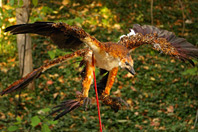
Microraptor, a headline-making, four-winged dinosaur, is just one piece of the baffling puzzle of how birds evolved from reptiles. 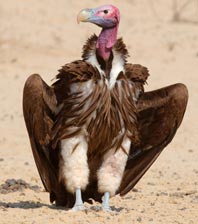
Resembling a creature from Jurassic Park, the lappet-faced vulture offers striking visual evidence of how closely akin birds are to dinosaurs. 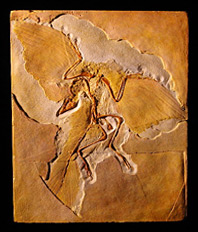
Fossils of Archaeopteryx, first discovered in the 1860s, were among the earliest evidence of the dinosaur-bird connection. 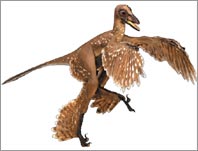
Perhaps many dinosaurs had feathered feet? Here, artist Jason Brougham of the American Museum of Natural History shows how Sinornithosaurus ("Chinese bird-lizard") might have looked with a full set of feathers. 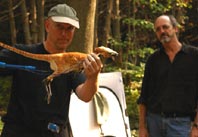
Producer Mark Davis (in background) scopes out a scene with puppeteer Fred Stinson. Davis first explored the dinosaur-bird connection in his 1991 NOVA "Case of the Flying Dinosaur." |
|
Mark Davis is the producer of "The Four-Winged Dinosaur." See his suggestions for further reading. The Four-Winged Dinosaur Home | Send Feedback | Image Credits | Support NOVA |
© | Created February 2008 |

